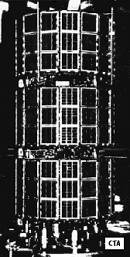Stacksat
Stacksat was an American military project that involved the launch of three similar spacecraft: POGS (Polar Orbiting Geomagnetic Survey), TEX (Transceiver Experiment), and SCE (Selective Communications Experiment). POGS carried a magnetometer to map Earth's magnetic field. Data from the experiment will be used to improve Earth navigation systems, and is stored in an experimental solid state recorder. TEX carries a variable power transmitter used to study ionospheric effects on radio frequency (RF) transmissions. Data from the experiment will be used to determine minimum spacecraft transmitter power levels for transmission to ground receivers. SCE carries a variable frequency transmitter to study ionospheric effects at various RF frequencies, and is also designed to demonstrate message store and forward techniques. Six low cost ground stations were designed, built and located around the world to operate these spacecraft. POGS carries a magnetometer to accurately map Earth's magnetic field for the Defense Mapping Agency.
 |
| launch date | Apr 11, 1990 |
| launch vehicle | Atlas E |
| launch site | Cape Canaveral |
| orbit (circular) | 741 km × 90° |
| mass (each) | 68–72.6 kg |


